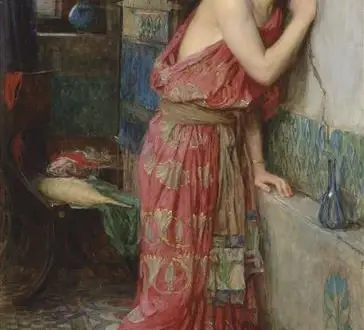Title of Artwork: “Thisbe”

Artwork by John William Waterhouse
Year Created 1909
Summary of Thisbe
In Ovid’s Metamorphoses, Thisbe (1909) illustrates a scene from the tale of Thisbe and Pyramus. A young woman named Thisbe falls in love with her next-door neighbour, Pyramus, but the two are forbidden from marrying by their families, who are bitter enemies.
All About Thisbe
The young lovers speak with one other through a gap in the wall shared by their families’ homes: they declare their love and plan a meeting near Ninus’s grave. That being said, while a series of catastrophic events happen, Thisbe is the one who shows there first.
Her veil falls to the ground as she flees from a lioness that has approached in her absence. On his way back, Pyramus falls on his sword, mistaking Thisbe for having been devoured. His corpse is found by Thisbe in the mulberry trees. She stabs herself with the same blade in her despair. According to legend, the mulberry tree’s fruit became permanently stained with the blood of the lovers who ate it.
In the late 1300s, Geoffrey Chaucer recounted the narrative in Legend of Good, and in 1595, William Shakespeare retold it in A Midsummer Night’s Dream and Romeo and Juliet. Unfulfilled love stories that finish with a lady reverting to her natural shape attracted to the artist, and the story of Thisbe fit that bill well. When he painted Echo and Narcissus (1903) and Apollo and Daphne (1908) in the same decade, Echo dissolves into a whisper after being spurned by Narcissus, and Daphne becomes a laurel tree as she flees Apollo.
First exhibited in 1909 at the Royal Academy, Thisbe and its accompanying picture Lamia were favourably appreciated by critics. The model in the works Ophelia (1910) and Penelope and the Suitors (1911) was a favourite of the artist and her name is unknown (1912). Thisbe has risen from her weaving and is holding her ear to the crack in the wall to hear Pyramus’s words.
Sewing and embroidering were traditionally connected with domesticity and femininity at the time of the artist, in part because the Virgin Mary was depicted as working on a project on her own loom. I Am Half-Sick of Shadows, Said the Lady of Shalott (1915) and Penelope and the Suitors (1915) are two examples of Waterhouse’s heroines being depicted weaving (1912).
Because Thisbe is located in Babylon, Waterhouse incorporated various Oriental themes into the picture. Although his choices were not well researched or historically correct, the stool in the front and the lotuses on Thisbe’s gown are Egyptian, the window transom is Islamic, tiles on the right wall are Ottoman and the flooring appears to be Roman.
Waterhouse’s interest in Eastern cultures and his ambition to depict a distant past through these exotic aspects are reflected in this mash-up of inspirations..”
Information Citations
En.wikipedia.org, https://en.wikipedia.org/.
Recommend0 recommendationsPublished in Artworks


Responses